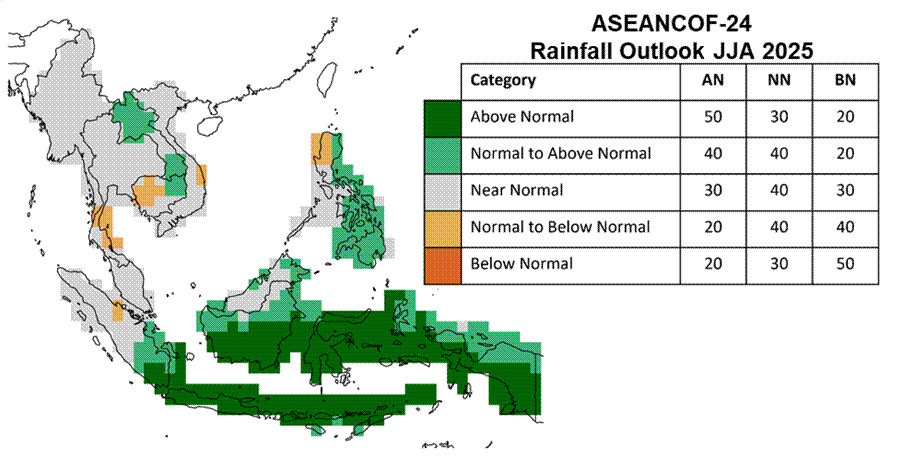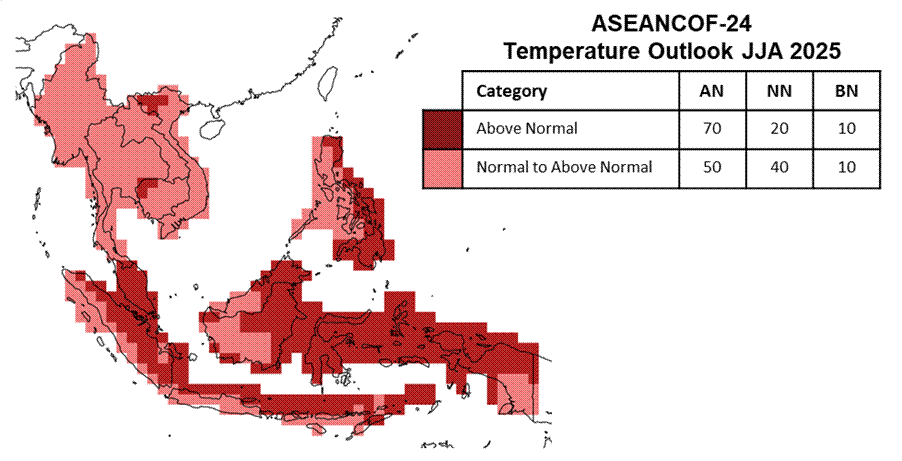Twenty Fourth Session of the ASEAN Climate Outlook Forum (ASEANCOF-24)

22 – 25 April 2025, MOWRAM Cambodia
Consensus Bulletin for June-July-August (JJA) 2025 Season
The ASEAN Climate Outlook Forum (ASEANCOF) is an avenue to collaboratively develop consensus-based seasonal climate outlooks and related information on a regional scale. The forum’s outlook and its activities contribute significantly to one of the key roles of the ASEAN Specialised Meteorological Centre (ASMC), which is to conduct climate and seasonal prediction for the Association of Southeast Asian Nations (ASEAN) region through pooling the expertise of ASEAN National Meteorological and Hydrological Services (NMHSs). In 2021, the ASEANCOF Working Group was established with the goal to guide and support the long-term development of ASEANCOF, in particular with regard to the implementation of objective outlooks.
The Twenty-Fourth session of ASEANCOF (ASEANCOF-24) was organised by the Ministry of Water Resources and Meteorology, Cambodia (MOWRAM), RIMES, ASMC, the ASEANCOF Working Group, and WMO. A two-day training workshop occurred prior to the COF proper, with training by the UK Met Office, ASMC, and University of Southern Queensland (22 – 23 April).
During the COF proper, participants from the NMHSs of ASEAN Member States created a consensus forecast for the boreal summer monsoon 2025 in the ASEAN region. The consensus for the June-July-August (JJA) 2025 outlook was achieved through a hybrid session, which included presentations from NMHSs, questionnaires, and discussions regarding the current climate conditions and predictions for Southeast Asia. The theme of ASEANCOF-24 was Climate Services and Heat Health. On the last day of ASEANCOF-24, a sharing session was held by the Global Heat Health Information Network (GHHIN) Southeast Asia Hub, followed by a general sharing session by various sector representatives and producers, including UN ESCAP, FAO, and agricultural and health representatives from Lao PDR and Cambodia. A recording of the COF proper is available at https://community.wmo.int/en/meetings/24th-association-southeast-asian-nations-asean-climate-outlook-forum-aseancof-24.

Conditions and Outlook
Recent analysis of sea surface temperature (SST) anomalies over the equatorial Pacific shows average to slightly below-average SSTs across the equatorial Pacific Ocean, and along with atmospheric indicators such as trade wind strength and cloudiness, indicate ENSO-neutral conditions. In the Indian Ocean, the Indian Ocean Dipole (IOD) is neutral.
The international climate outlook predicts that ENSO-neutral conditions will continue into JJA 2025. After JJA 2025, most models predict ENSO-neutral conditions, although there is still a high amount of uncertainty for ENSO predictions issued in April.
The Indian Ocean Dipole (IOD) is also predicted to be neutral during JJA 2025.
The onset of the Southwest monsoon season is predicted to be near average for most of Southeast Asia in 2025, starting from May. The strength of the Southwest monsoon is predicted to be near-average over most of Southeast Asia, based on model predictions.
During JJA 2025, tropical cyclone frequency is predicted to be near average around the Philippine Sea and the South China Sea and above average over the Bay of Bengal.
RAINFALL
For the upcoming boreal (Northern Hemisphere) summer season (JJA 2025):
Above-normal rainfall is predicted over parts of the southern ASEAN region. Near- to above-normal rainfall is predicted over eastern and southern Philippines, parts of east Malaysia, Brunei Darussalam, northeastern Cambodia, and northern and southern Lao PDR.Below- to near-normal rainfall is predicted over parts of southern Thailand, northwestern Cambodia, coastal central Vietnam and northwestern Philippines.
Elsewhere, near-normal rainfall is predicted.
TEMPERATURE
For the upcoming boreal (Northern Hemisphere) summer season (JJA 2025):
Above-normal temperature is predicted over much of the equatorial region, as well as over eastern and southern Philippines and parts of northern Viet Nam and northwestern Cambodia.Elsewhere, near- to above-normal1 temperature is predicted.
1For this outlook, near-to above-normal temperature corresponds to 50% probability of above-normal temperature, 40% near-normal, and 10% below-normal. Further information is in the consensus maps.
Refer to Annex A for reference on what is meant by “above, near, or below normal” in the outlook. For more information on the boreal (Northern Hemisphere) summer monsoon outlook and further updates on the national scale, the relevant NMHSs should be consulted (see Annex B).
CONSENSUS MAPS FOR JJA 2025
The following maps provide the probabilistic outlooks for JJA 2025 season in terms of tercile categories of “Above Normal” (AN: upper tercile), “Near Normal (NN: middle tercile) and “Below Normal” (BN: lower tercile).
PROBABILISTIC RAINFALL OUTLOOK
PROBABILISTIC TEMPERATURE OUTLOOK
Meeting Documents
Acknowledgements
ASEANCOF would like to convey its appreciation to the NMHSs of the ASEAN Member States for sharing their national level forecasts, the Global Producing Centres, the Southeast Asia Regional Climate Centre – Network, RIMES, UN ESCAP, FAO, USQ, GHHIN Southeast Asia Hub and other partners of ASEANCOF for sharing their products and expertise, and the World Meteorological Organization Regional Office in Asia and the Southwest Pacific (WMO-RAP) for their continued support of ASEANCOF. The Forum would also like to thank MOWRAM Cambodia for hosting the forum, with support from RIMES, CREWS and WISER Asia Pacific for the funding support provided for the meeting.



